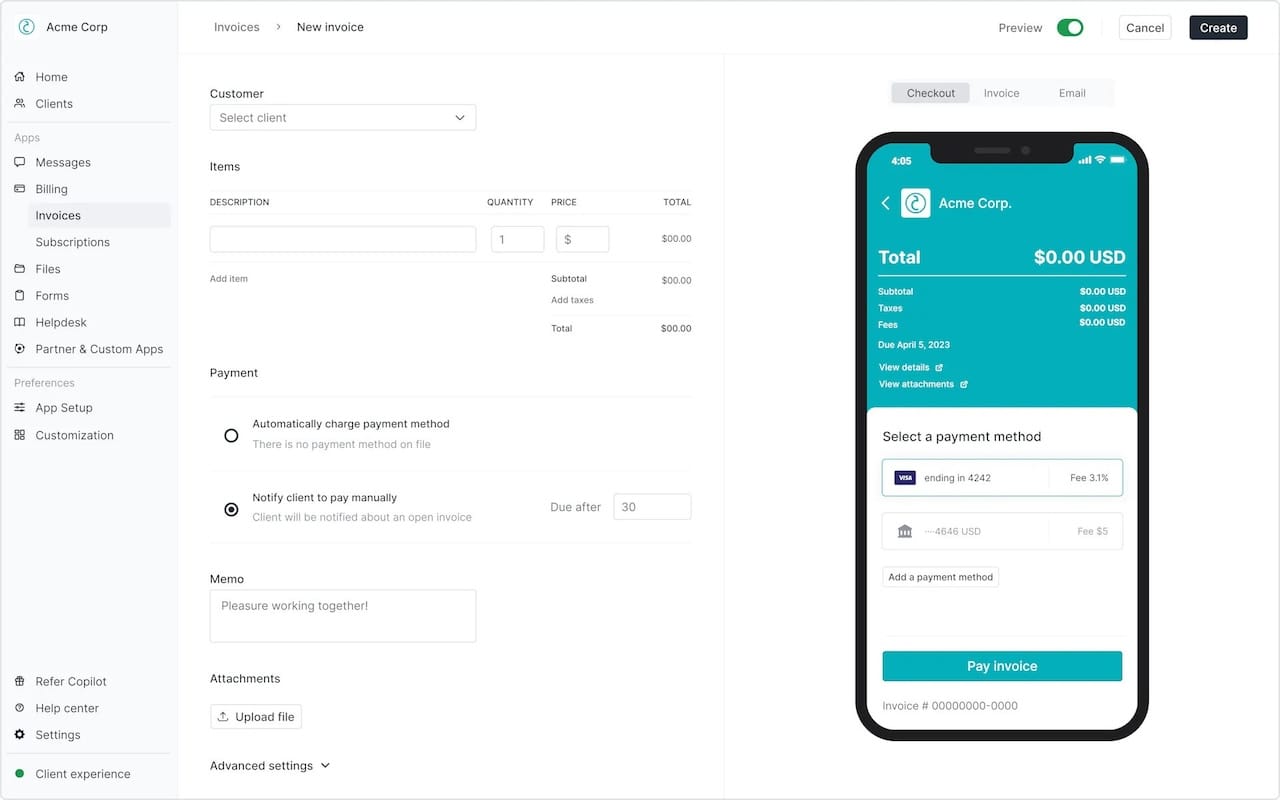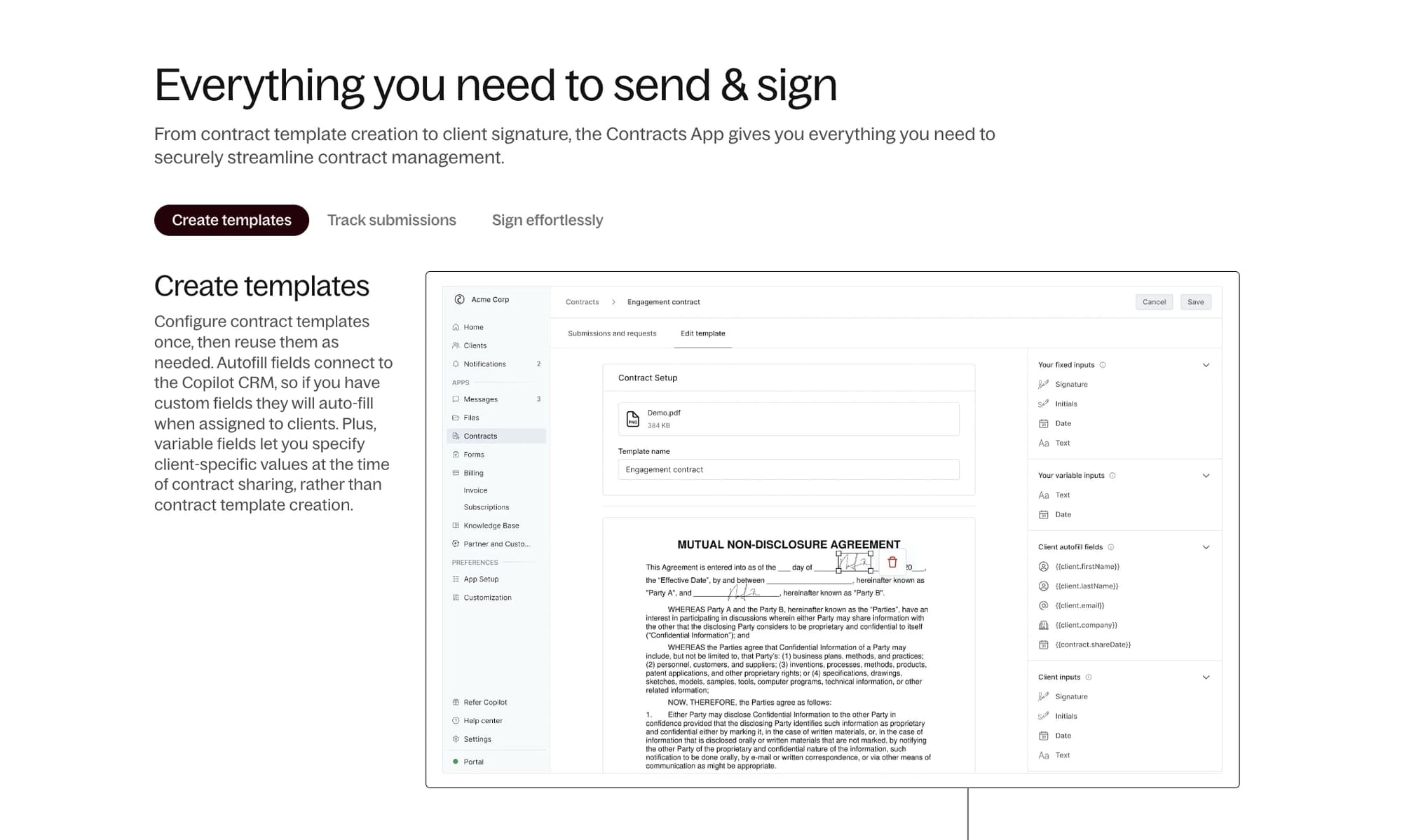
Running a business involves spinning many plates — you have to juggle onboarding clients, delivering on projects, managing finances, finding more clients, and numerous other responsibilities. With all those pressing needs competing for your time, important but less exciting stuff like contracts often gets pushed down the list.
But taking a few minutes to put client guidelines in writing sets up your business and your clients for success. That's where Copilot comes in. Our simple platform takes the headache out of client contracts. It lets you easily make customized templates, track status, and get easy e-signatures.
With Copilot taking this critical task off your plate, you can focus on doing what you do best versus getting stuck in paperwork.
However, before we dive in, I want to note that I am not a legal advisor. The information in this article is sourced from what is mentioned on the web and from my personal experience. I would highly recommend seeking legal advice from a professional service provider. Alright, let’s get into it!
What is a client contract?
A client contract is a legally binding document between a business and a client that lays out the terms of working together. Client contracts act as a legal document and are used in nearly every industry out there. Marketing agencies, web design shops, consultants, writers, accountants, lawyers, architects — you name it.
These agreements might be called "service contracts," "client service agreements," or "client agreements." But they all serve the same core functions:
- Formalize the scope of work
- Set payment terms
- Protect both parties
- Foster clear communication
Without clear documentation in writing, projects can quickly veer off track. That leads to problems getting paid, quality issues, unmet expectations, and other headaches.
Why client contracts are crucial
Some people think client contracts are only necessary for big agencies or corporations. But that couldn't be more wrong. Clear, binding client contracts benefit independent contractors, entrepreneurs, and freelancers in lots of ways.
Let’s look at a few reasons why client contracts are important.
Two-way protection
One of the biggest upsides of client contracts is two-way protection. Your agreement shields your interests while also protecting customers.
For example, say a client doesn't pay your invoice on time. With no contract outlining payment terms, your options are limited. You could take them to small claims court, but that takes time and money without a guarantee you'd win.
However, with a solid client contract stipulating 30-day payment terms, you have the legal standing to compel the client to pay more easily.
It goes both ways, too. If you fail to deliver contracted services due to negligence or other factors in your control, the client can use your legally binding agreement to recover losses more easily.
Level-setting
A detailed client contract also sets clear expectations so both parties understand what's expected. Mismatched expectations are a breeding ground for miscommunications. And that leads to confusion, disputes, or other issues. Comprehensive contracts mitigate this risk.
For example, you might agree to create social media graphics for a client without formally documenting expected turnaround times. After a day, the client gets frustrated that you don't deliver new designs. They anticipated a 12-hour turnaround.
You expected 48 hours to be reasonable, and you were caught off guard by their urgent requests. Both parties end up frustrated, which strains your business relationship. Defining exact expectations for turnaround times in a client contract from the start prevents this.
Professionalism
Finally, putting client contracts in place simply looks more professional. Legal contracts demonstrate you take projects seriously and operate like an established business. This perception of professionalism can go a long way toward landing new work and getting taken seriously by clients.
8 essential sections to include in client contracts
Now that you know why solid client contracts are so critical for your freelance business, let's explore what should be included.
Here are nine things you should include in every client contract:
- Contact information
- Payment terms
- Scope of work
- Termination clause
- Cancellation clause
- Confidentiality clause
- Indemnification clause
- Type of service
Okay, let’s take a deeper look at what each of these entails.
1. Contact information
Every contract needs to clearly identify names and contact information for everyone entering the agreement. This includes:
- Legal business names and primary contacts
- Physical addresses
- Billing addresses
- Phone numbers
- Email addresses
Use your exact registered business name if you have an LLC or corporation. Getting your own business name right shows clients you mean business, while incorrect or informal names appear sloppy.
2. Payment terms
As a freelancer or solopreneur, getting paid for your hard work is non-negotiable. That's why clearly laying out payment terms is mission-critical in client contracts.
Consider mentioning:
- When is payment due?
- How much is owed, and when?
- Which methods of payment are acceptable?
- How are late payments handled?
Nailing down these details early prevents payment issues and headaches down the road.
Payment timeline
Be highly detailed when it comes to defining payment schedules. Do you bill clients weekly, monthly, or after project completion? When is payment due — 15, 30, or 60 days after you bill them?
Outline this clearly so both sides understand when invoices are sent and when payments are expected. For extra protection, stipulate precise late fees charged if your client does not comply with payment terms.
Pricing
Take time to comprehensively document the agreed pricing in your contracts. Define the total price owed along with itemized rates for your services. List any supplementary costs not covered in your fees that could arise over the course of a project. These details make financial expectations black and white.
Payment methods
Finally, outline which payment methods you accept and any associated processing fees. For example, clarify if you take credit cards, PayPal, bank transfers, checks, or other online payment platforms. Define which party pays processing fees or if they're split evenly.
Leaving anything related to payment fuzzy in your client contract is asking for future problems. So be meticulously detailed here, even if it takes a little extra time upfront. Doing so gives both parties financial clarity from day one while heading off non-payment issues.

This is why Copilot created their billing app. You can now easily send branded invoices or set up recurring payments so you never have to worry about chasing down clients to get paid.
3. Scope of work
While payment sections focus on financial expectations, the scope of work details precise deliverables and client needs expected over the course of your client engagement. This includes:
- Services you will provide
- Project timeline and milestones
- Number of revisions or optional add-ons
- Communication protocols
- And more
Without clearly documenting Scope of Work, projects can quickly veer off the rails if client expectations don't match what you plan to provide. Mismatched scopes lead to quality issues, budget problems, and missed deadlines down the road.
Include deliverables
Thoroughly list projects, services, features, or products you will provide. Avoid vague "creative services"-style scopes by breaking deliverables into detailed line items.
Define timelines
Then, outline precise project timelines, including individual milestone dates. Provide time estimates for completing specific deliverables and define the overall project length.
Specify revisions
Next, indicate how many rounds of revisions or optional add-ons are included in your base pricing. Define your revision policy — will you address minor tweaks only or make significant changes?
Get communication protocol
Finally, document expected communication methods and response times. Will you communicate primarily by email, phone, or video calls? How quickly will you address urgent issues outside regular business hours?
Defining these Scope of Work details upfront aligns expectations to keep projects on track. Doing so heads off scope creep down the line and the budget/deadline headaches that come with it.
4. Termination clause
Termination clauses allow either party to legally end agreements if certain conditions are met — like both sides completing all deliverables as initially outlined.
Contracts can be terminated under friendly terms if the scope of work is finished and no obligations remain outstanding from any party. In cases like these, termination clauses provide an orderly exit while avoiding future liability for either side.
These sections define conditions allowing early termination without penalty, financial or otherwise. Reasons could include unexpected loss of client budget, central company pivot in strategic direction, or failure to achieve predefined progress milestones after reasonable faith efforts.
Having clearly defined termination protocols in place makes sure cancellations happen responsibly rather than unilateral departures occurring rashly mid-project. Clauses tend to establish:
- Valid termination grounds
- Required notification timeframes
- Post-termination financial and IP responsibilities
5. Cancellation clause
While termination clauses deal with ending contracts cleanly, cancellation clauses outline recourse if one party breaches the agreement. No one likes thinking about contracts ending badly or needing to walk away from a client.
But having cancellation clauses in your client contracts is still essential, just in case. These sections serve as the stick motivating both sides to uphold responsibilities tied to your services agreement.
Cancellation clauses define:
- Acceptable vs unacceptable reasons for contract cancellation
- Steps each party must take when canceling an agreement
- How to calculate cancellation damages
Say a client disappears and stops all communication for over a month, bringing your project to a standstill. You've already invested significant time and resources into this fixed-price agreement.
In this case, you could invoke your cancellation clause due to the client breaching your contract. Following the proper steps defined in the clause, you legally withdraw services while recovering fair compensation for your losses.
Without a cancellation clause, you might need to keep extending project timelines indefinitely, waiting for an unresponsive client to reappear. Meanwhile, you rack up significant opportunity costs from being unable to take on new, paying projects. As such, include:
Fees due
Indicate how to calculate pricing for services provided if contracts end prematurely. Will you charge hourly or prorate costs if you complete 35% of deliverables before a project gets cut short? These variables influence how termination clauses get structured.
Dispute resolution
Have procedures outlined just in case conflicts arise regarding contract cancellation. Will unresolved issues get handled in small claims court or first require mediation? Consider the time and money needed if these options must be used down the line.
Carefully structuring termination clauses lets you withdraw more cleanly if client relationships go unexpectedly sideways or other issues emerge mid-project.
6. Confidentiality clause
Clients might share proprietary information with you during your career to provide requested services. Confidentiality clauses require you to keep this sensitive information private.
These sections prevent you from sharing or profiting from inside knowledge of client products, technology, processes, or other intellectual property (IP) accessible based on your working relationship.
For example, the recipe used in a food company's tuna salad stays private. Advertising agencies avoid exposing marketing campaign budgets to competitors. Law firms keep case strategies under wraps. The list goes on - countless details could compromise your clients if made public or used for personal gain.
That's why contract confidentiality clauses establish legal ramifications if sensitive information gets deliberately or accidentally leaked. These sections cover specifics like:
- Timeframes: Confidentiality clauses remain in effect indefinitely or for X years after project completion, depending on the sensitivity levels of information exposed during your engagement.
- Covered materials: What constitutes "confidential" information ranges from client data stored in your accounting system to product prototypes clients provide for design enhancement projects.
- Exceptions: Instances where you must violate confidentiality, like court orders to reveal protected information. But subpoenas for info get contested first based on signed confidentiality clauses to avoid disclosures if possible.
- Repercussions: Legal consequences if leaks stem from you or your staff, like pre-set financial damages.
7. Indemnification clause
Ask ten small business owners to define the "indemnification clause," and you'll likely get blank stares. But these contract sections provide pivotal financial protection, making them well worth understanding.
In plain English, indemnification clauses require clients to cover you financially on specific issues tied to your services. In legal jargon, clients "indemnify" you against covered costs.
At its simplest, indemnity means your client will pay damages, attorney fees, or other expenses if third parties sue you for issues potentially stemming from your work together. Essentially, clients financially compensate or reimburse you for covered legal costs.
For example, say a visitor trips on a loose step at your client's office, where you recently provided landscaping services. They sued your client and looped your business in, claiming poor patio construction work contributed to the fall.
Rather than paying ruinous legal fees battling allegations, your client covers associated expenses based on the indemnification clause included in their landscaping contract.
8. Type of service
Like detailing the Scope of Work, documenting your exact type of service clarifies the project focus for both parties.
Defining the overarching nature of services provided helps match appropriate skills and resources for fulfilling contracts properly. Doing so sets work categories expected like:
- Web design
- Graphic design
- Writing
- Accounting
- Business Consulting
- And more
For example, listing "freelance services" on a client contract is ambiguous. "Search engine optimization consulting and content production" sets precise expectations.
Additionally, Type of Service classifications help substantially for tax preparation and accounting purposes later. When filing tax returns, you want clean documentation of income sources coming from clearly defined areas.
So, take a little extra time when completing client contracts to designate categories for your services precisely.
Get your contracts signed seamlessly with Copilot

Crafting solid client contracts protects us, but it eats up our time better spent wowing customers. Copilot, though, makes it simple with handy templates to alter fast and friendly client signing built-in.
With Copilot, you can centralize the whole process so you can reuse agreement templates instead of making each from scratch. Details like names and figures pull right in automatically!
Clients can also electronically sign contracts, and Copilot tracks the status of each client so you can find what has and has not been signed yet. This is a big relief compared to chasing papers or using spreadsheets. If you’re ready to operationalize your service business, be sure to give Copilot a spin with a free trial.
Share this post
Sign up for our newsletter
Subscribe to our newsletter to receive emails about important announcements, product updates, and guides relevant to your industry.
